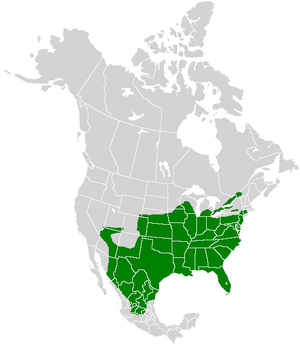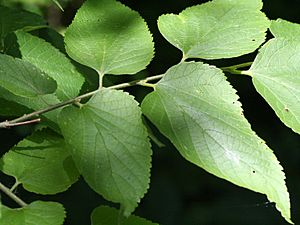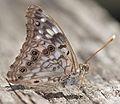Hackberry emperor facts for kids
Quick facts for kids Hackberry emperor |
|
|---|---|
 |
|
| Conservation status | |
| Scientific classification | |
 |
The hackberry emperor (Asterocampa celtis) is a cool butterfly found in North America. It's part of a group called brush-footed butterflies. This butterfly gets its name from the hackberry tree, which is super important to it. The hackberry tree is the only plant where the hackberry emperor lays its eggs. It's also the only food source for the young caterpillars.
This butterfly is known for being very fast and quick-changing in its flight. You often find it near water, like rivers, or in low-lying areas. But it can live in many different places too. One interesting thing about the hackberry emperor is that it hardly ever visits flowers. This is pretty unusual for a butterfly!
Scientists sometimes call butterflies like the hackberry emperor "cheaters." This is because they don't help pollinate flowers when they feed. Instead, they just take nutrients from plants without giving anything back.
Like other brush-footed butterflies, the female hackberry emperor lays her eggs in groups. She places them on the underside of hackberry leaves. There are a few ideas why they do this, but it might help them have more babies. Sometimes, their warning colors might also play a role.
Contents
Where Do Hackberry Emperors Live?
The hackberry emperor lives in a huge area across North America. You can find it as far south as central Mexico and up north into parts of Eastern Canada. Its home also stretches southwest into places like Arizona and New Mexico, and other parts of the Rocky Mountains.
It's very common in the Midwest. You can also spot it all along the east coast, from Florida up to New England.
What Kind of Habitat Do They Like?
Asterocampa celtis lives wherever hackberry trees grow. There are many types of hackberry trees, and this butterfly doesn't prefer one over another. You can find these butterflies in cities, forests, and wooded areas. They especially love places near rivers or other water sources.
Human buildings and developments don't bother them much. You might see hackberry emperors near the edges of woodlands, by creeks, around buildings, or in damp, muddy spots.
What Do Hackberry Emperors Eat?
Caterpillar Food
The young hackberry emperor caterpillars (larvae) eat the leaves and leaf buds of hackberry trees. After they sleep through the winter, they have to climb back up the tree to find food. These caterpillars can eat so much that they sometimes eat all the leaves off a tree!
Adult Food
Adult hackberry emperors eat many different things. They rarely visit flowers, so they don't drink much nectar. Instead, they often eat sap from hackberry trees. They also feed on animal waste, dead animals (like pigs, snakes, or dogs), and old fruit.
They drink water from puddles. Sometimes, they even land on humans to lick sweat. They do this to get salt (sodium) from our skin!
How Do Hackberry Emperors Reproduce?
Laying Eggs
Female hackberry emperors usually lay their eggs in groups. They place them on the underside of hackberry leaves. Sometimes, they might lay eggs on the top of a leaf too. Laying eggs in groups helps the female have more offspring.
One reason for laying eggs in clusters might be that it saves time and energy. The female doesn't have to search for many new leaf spots. This also lowers the risk of the mother dying between laying eggs. For the hackberry emperor, laying eggs in groups is the best way to have the most babies.
The Hackberry Emperor Life Cycle
Egg Stage
The eggs are pale and laid in groups of 5 to 20 on the hackberry tree. They look white with a light green-yellow color.
Larva (Caterpillar) Stage
The caterpillar's body is about 1.4 inches (3.5 cm) long. Its head has brown-black horns on top. The body is mostly green with whitish-yellow bumps. At the back, it has two sharp tails sticking out.
Half-grown caterpillars sleep through the winter (hibernate) in fallen hackberry leaves on the forest floor. In the spring, they wake up and climb back up the hackberry tree to eat the leaves.
Pupa Stage
The pupae are dark green with white spots all over their bodies. They also have white lines that go diagonally across their middle section.
You can find pupae on the underside of hackberry leaves. They change into adult butterflies in the early summer.
Adult Stage
Adult hackberry emperors look a bit different depending on if they are male or female. This is called sexual dimorphism. Males are smaller and darker, with thinner wings than females. Both males and females are light brown. They have a row of black or white dots near the outer edge of their wings. White spots near the front of their wings help tell them apart from a similar butterfly, the Tawny Emperor.
Adult hackberry emperors have two sets of offspring (broods) each year. Because they have multiple generations in one year, you might see eggs, caterpillars, pupae, and adult butterflies all at the same time in one place!
Why Are They Called "Cheaters"?
The hackberry emperor visits flowers in a very unusual way. When it does visit a flower to feed (which is rare), it makes sure its feet or antennae don't touch the flower. Only its feeding tube (proboscis) touches parts of the flower. This means the butterfly probably doesn't help pollinate the flower at all.
This is why it's called "cheater" behavior. Usually, when butterflies visit flowers, both the butterfly and the plant benefit. The butterfly gets food, and the plant gets help with pollination. But the hackberry emperor doesn't seem to help with pollination in any important way.
Who Are Their Enemies?
Predators
Animals that eat many different things, like birds and mammals (such as bears and raccoons), will eat caterpillars found on the forest floor. The stink bug is also a very common predator that eats hackberry emperor eggs.
Parasites
Tiny scelionid wasps are egg parasites that attack many types of Asterocampa butterflies, including the hackberry emperor. A type of tachinid fly called Chetogena edwardsii is another common threat to the hackberry emperor.
How Do They Find Mates?
Male butterflies usually have two ways of looking for a mate. One way is to actively fly around an area searching for females. These "patrollers" are attracted to still objects that look like a mate. The other way is to "perch." Perchers spend only part of the day actively looking for a mate. They sit on a branch and wait for a female to fly by. When a male sees movement nearby, it quickly flies out to try and mate, but it stays within a small area.
A. celtis males use the perching method. The male rests on rocks, trees, or fallen branches, often near streams. They do this from the afternoon until around sunset.
Conservation Status
The hackberry emperor is not in any serious danger. You can commonly find it throughout most of the areas where it lives.
Gallery
-
In Denton, Texas, United States
-
In Butler County, Kansas, United States
See also
 In Spanish: Asterocampa celtis para niños
In Spanish: Asterocampa celtis para niños










